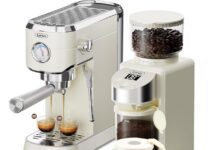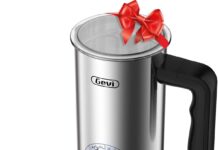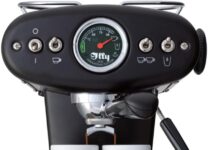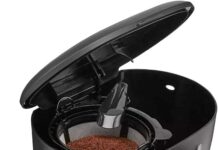Ever wondered why your morning coffee routine involves a peculiar dance of dodging drips and spills from your trusty coffee maker? Well, fret no more, because we’ve got the solution! In this article, we’ll share some simple yet effective tips to help you bid farewell to those annoying coffee drips once and for all. So grab a cup of joe, sit back, and get ready to enjoy a mess-free morning coffee experience.
Check the Coffee Pot
When it comes to ensuring a perfect cup of coffee, it’s important to start with a clean and functioning coffee pot. Over time, residue from brewed coffee can accumulate in the pot, leading to a less-than-desirable taste and potential dripping issues. To avoid this, it is recommended to regularly clean and replace the coffee pot.
Clean the coffee pot
Cleaning the coffee pot is a simple task that can make a significant difference in the quality of your coffee. Start by emptying any remaining coffee from the pot and rinsing it with warm water. Use a gentle dish soap or a solution of equal parts water and vinegar to remove any stains or build-up. Scrub the pot with a soft brush or sponge, paying extra attention to the spout and the inside corners. Rinse the pot thoroughly to ensure no soap or vinegar residue remains before using it again.
Replace the coffee pot
If you’ve been experiencing persistent dripping issues with your coffee maker, it may be time to consider replacing the coffee pot. Over time, the glass may become scratched or the spout may not function properly, leading to leaks and drips. Check with the manufacturer of your coffee maker or search for compatible replacement pots online or in your local store. Investing in a new, high-quality coffee pot can ensure a smooth and drip-free brewing experience.
Inspect the Filter
Alongside a clean coffee pot, a clean and functioning filter is essential in preventing coffee maker dripping issues. The filter is responsible for capturing any grounds or sediments, ensuring a smooth and flavorful cup of coffee. Regularly inspecting and maintaining the filter can help prevent drips and improve your overall brewing experience.
Clean the filter
If you notice a build-up of oils or residue on your coffee filter, it’s time to give it a thorough cleaning. Start by removing the filter from the coffee maker and emptying any used grounds into the compost or trash. Rinse the filter with warm water to remove any loose debris. For a deeper clean, you can use a gentle dish soap or a mixture of equal parts water and vinegar. Gently scrub the filter to remove any stubborn build-up. Rinse the filter thoroughly, ensuring no soap or vinegar residue remains before using it again.
Replace the filter
If cleaning the filter doesn’t resolve your coffee maker’s dripping issues, consider replacing the filter altogether. Over time, filters can become clogged or torn, leading to grounds escaping into your coffee and causing drips. Check the model number or size of your coffee maker’s filter to ensure you purchase the correct replacement. High-quality filters are readily available online or in stores, ensuring a clean and drip-free brewing process.
Examine the Water Reservoir
The water reservoir of your coffee maker plays a crucial role in the brewing process. It holds the water that will be heated and extracted through the coffee grounds. Regularly examining and maintaining the water reservoir can help prevent dripping issues and keep your coffee maker in optimal condition.
Clean the water reservoir
To ensure a clean and drip-free coffee brewing experience, it is important to clean the water reservoir regularly. Begin by emptying any remaining water from the reservoir and rinsing it with warm water. If there are any visible stains or build-up, use a mild dish soap or a mixture of equal parts water and vinegar to gently clean the reservoir. Scrub the interior with a soft brush or sponge, paying attention to any hard-to-reach areas. Rinse the reservoir thoroughly to remove any soap or vinegar residue before using it again.
Replace the water reservoir
In some cases, the water reservoir may be damaged or worn out, leading to dripping issues. If you’ve tried cleaning the reservoir but are still experiencing problems, it may be necessary to replace it. Contact the manufacturer of your coffee maker to inquire about replacement parts or search online for compatible water reservoirs. Investing in a new reservoir can ensure a proper fit and eliminate any potential dripping caused by a faulty component.
Check the Water Level
Proper water level is essential for a well-brewed and drip-free cup of coffee. Too little water can result in a weak and unsatisfying brew, while too much water can overflow and cause dripping issues. Regularly checking and adjusting the water level in your coffee maker can help maintain optimal brewing conditions.
Ensure proper water level
Before starting the brewing process, always ensure that the water level in the reservoir is appropriate for the desired number of cups you intend to brew. Most coffee makers have clearly marked indicators or measurements on the side of the water reservoir, making it easy to determine the correct water level. Ensure that the water level does not exceed the maximum limit and that it is sufficient for the amount of coffee you want to brew.
Adjust the water level
If you’ve been experiencing dripping issues with your coffee maker, it may be necessary to adjust the water level to find the optimal balance. Experiment with slightly increasing or decreasing the water level and observe the brewing process to see if the dripping issue persists. Avoid overfilling the reservoir, as this can lead to overflow and subsequent dripping. Finding the right water level for your specific coffee maker may require a bit of trial and error, but it is crucial in achieving a drip-free brewing experience.
Clean the Coffee Maker
A clean coffee maker is not only important for its appearance but also for the taste and functionality of your brewed coffee. Over time, mineral deposits and coffee residue can build up both on the exterior and interior surfaces of the machine, leading to clogs and dripping issues. Regularly cleaning your coffee maker can help maintain its performance and prevent unwanted drips.
Clean the exterior
To keep your coffee maker looking clean and presentable, regularly wipe down the exterior surface with a damp cloth. Pay close attention to any areas that may have stains or spills, such as the control panel or the base of the machine. Avoid using abrasive cleaners or scrub brushes, as they can damage the finish of your coffee maker. A gentle cleaning solution made with water and mild dish soap is usually sufficient for removing any dirt or grime.
Descale the interior
Hard water deposits can accumulate inside your coffee maker, affecting the functionality and causing dripping issues. Descaling the interior of your machine can help remove these mineral deposits and ensure a smooth brewing process. Refer to the manufacturer’s instructions for the appropriate descaling method for your specific coffee maker model. Typically, a mixture of equal parts water and white vinegar is used to clean the internal components. Run a descaling cycle or brew several cycles of the vinegar solution followed by plain water to flush out any residue. This process should be performed regularly, especially if you live in an area with hard water.
Check the Brew Basket
The brew basket is where the coffee grounds are placed during the brewing process. It is crucial to keep this component clean and free from clogs to prevent any potential dripping issues. Regularly checking and maintaining the brew basket can ensure a steady flow of water and a flavorful, drip-free cup of coffee.
Clean the brew basket
After each use, remove the used coffee grounds from the brew basket and discard them. Rinse the brew basket with warm water to remove any residual grounds or oils. If necessary, use a brush or sponge to gently clean any stubborn residue. Make sure to thoroughly rinse the brew basket to remove any soap or coffee residue before using it again. Keeping the brew basket clean is essential in preventing grounds or residue from blocking the water flow and causing dripping issues.
Replace the brew basket
If your coffee maker continues to drip even after thoroughly cleaning the brew basket, it may be time to consider replacing it. Over time, the mesh or plastic components of the brew basket can become worn out or damaged, leading to clogs and leaks. Consult the manufacturer of your coffee maker to inquire about replacement brew baskets or search for compatible options online. Investing in a new brew basket can restore proper functionality and eliminate any potential dripping issues.
Inspect the Water Tube
The water tube in your coffee maker is responsible for carrying water from the reservoir to the brewing mechanism. If this tube becomes clogged or blocked, it can disrupt the water flow and cause dripping issues. Regularly inspecting and maintaining the water tube can help prevent clogs and ensure a smooth brewing process.
Clean the water tube
To clean the water tube, start by unplugging your coffee maker and removing any remaining water from the reservoir. Use a small brush or pipe cleaner to carefully clean the water tube, ensuring all potential clogs or blockages are removed. Be gentle and cautious during this process to avoid damaging the tube. Once cleaned, reconnect the water tube securely and ensure it is properly fitted to prevent any leaks or dripping caused by a loose connection.
Unclog the water tube
In some cases, the water tube may become severely clogged or blocked, causing persistent dripping issues. If cleaning the tube does not resolve the problem, you may need to unclog it using more advanced methods. Consult the manufacturer’s instructions or contact their customer support for guidance on how to unclog the water tube specific to your coffee maker model. It is recommended to avoid using sharp objects or excessive force, as this can damage the tube or other components of your machine. Professional assistance may be required if unclogging the water tube becomes challenging.
Check the Anti-Drip Valve
The anti-drip valve, also known as the check valve, helps prevent coffee from dripping while the brewing process is paused or the pot is removed from the coffee maker. If this valve becomes dirty or faulty, it can lead to unwanted dripping. Regularly checking and maintaining the anti-drip valve can ensure a seamless and drip-free brewing experience.
Clean the anti-drip valve
To clean the anti-drip valve, start by unplugging your coffee maker and removing any remaining water from the reservoir. Locate the anti-drip valve; it is typically a small plastic or rubber component near the coffee pot or inside the brewing mechanism. Gently remove the valve and clean it with warm water and a mild dish soap solution. Pay attention to any debris or residue that may be blocking the valve’s proper function. Rinse the valve thoroughly to remove any soap residue before carefully reinstalling it.
Replace the anti-drip valve
If cleaning the anti-drip valve does not resolve the dripping issue, it may be necessary to replace the valve. Over time, the valve may become worn out or damaged, leading to leaks and drips. Contact the manufacturer of your coffee maker to inquire about replacement anti-drip valves or search for compatible options online. Investing in a new anti-drip valve can restore proper functionality and prevent any unwanted dripping during the brewing process.
Verify the Brewing Process
To ensure a delicious cup of coffee without any dripping issues, it is important to verify and adjust the brewing process of your coffee maker. Factors such as brewing time and temperature can significantly impact the taste and consistency of your coffee. Regularly checking and fine-tuning these aspects can help achieve the perfect brew.
Ensure proper brewing time
Different coffee makers and coffee types may require varying brewing times. It is important to consult the instructions provided with your coffee maker to determine the optimal brewing time for the best results. If your coffee maker is dripping excessively, you may need to adjust the brewing time. Brewing for too long can cause over-extraction, leading to bitterness and potential dripping issues. Experiment with slightly shorter brewing times to achieve a balanced and flavorful cup of coffee.
Adjust brewing temperature
The temperature at which your coffee is brewed can greatly affect its taste and consistency. If you are experiencing dripping issues, it is beneficial to check and adjust your coffee maker’s brewing temperature. Brewing at lower temperatures can result in under-extraction, leading to weak and unsatisfying coffee. On the other hand, brewing at excessively high temperatures can cause over-extraction and potential dripping. Consult the manufacturer’s instructions to see if your coffee maker allows temperature adjustments. Otherwise, experimenting with different coffee bean varieties and grind sizes can help achieve the desired taste and minimize dripping.
Service and Repair
If you have exhausted all cleaning and maintenance options and are still experiencing persistent dripping issues with your coffee maker, it may be time to seek professional assistance. Service and repair options can provide a comprehensive evaluation of your machine and offer solutions to resolve any underlying issues.
Contact the manufacturer
If your coffee maker is still under warranty, contacting the manufacturer should be your first course of action. Reach out to their customer support or refer to the warranty information provided with your machine. They will be able to guide you through the necessary steps to initiate a repair or replacement process if required. Provide them with detailed information regarding the dripping issues and any troubleshooting steps you have already taken.
Consult a professional technician
If your coffee maker is no longer under warranty or the manufacturer-approved solutions do not resolve the dripping issues, it may be necessary to consult a professional technician. Look for reputable appliance repair services in your area that specialize in coffee maker repairs. They will have the expertise and experience to diagnose and fix any underlying mechanical or electrical problems that may be causing the dripping. While the cost of professional repair may vary, it can be a worthwhile investment to restore your coffee maker’s functionality and prevent future drips.
In conclusion, preventing dripping issues with your coffee maker requires regular cleaning, maintenance, and careful observations of various components. By following the steps mentioned above, including cleaning the coffee pot, inspecting the filter, examining the water reservoir, checking the water level, cleaning the coffee maker, checking the brew basket, inspecting the water tube, and verifying the brewing process, you can ensure a drip-free and enjoyable coffee brewing experience. However, if all else fails, contacting the manufacturer or consulting a professional technician can provide further assistance in resolving any persistent dripping issues with your coffee maker. Cheers to a delicious and drip-free cup of coffee!





































